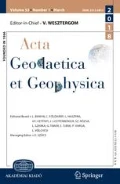Abstract
The physico-mechanical properties of five different intact rock types including sandstone, arkoses and limestone were determined through standardized laboratory tests. Ninety six specimens were tested to obtain the relationships between P-wave velocity (Vp), dry unit weight (DUW), uniaxial compressive strength (UCS), point load index Is(50), Brazilian tensile strength (TS), porosity (Φ), and Schmidt hardness (RN). This study also reviews some recent correlations between P-wave velocity and physico-mechanical properties as well as investigates the reliability of these correlations. Findings show the results of the experimental tests are in good agreement with previous studies. Statistical equations have been determined for estimating the physico-mechanical properties of rocks using nondestructive and indirect test methods. Results of regression analysis showed satisfactory correlations. Based on the results, new strong correlation with correlation coeffecients above (R2 > 0.80) are introduced for predicting the UCS, Is(50), Φ and RN and reasonable good correlations (R2 ≥ 0.78) are introduced to predict TS and DUW from P-wave velocity of different intact rock core samples. There is a discrepancy between P-wave velocity (Vp) in situ values with laboratory results. The large reductions in Vp in situ values are clearly the functions of fractures and natural joints.








Similar content being viewed by others
References
ASTM (1986a) Standard test method of unconfined compressive strength of intact rock core specimens. ASTM Publication
ASTM (1986b) Standard test method of unconfined compressive strength of intact rock core specimens. D2938
ASTM (2001) Standard practice for preparing rock core specimens and determining dimensional and shape tolerances, American Society for Testing and Materials, D4543
ASTM (2005) Standard test method for cyclic (Reversed) load test for shear resistance of walls for buildings. Annual book of ASTM standards. ASTM, West Conshohocken
ASTM D5873 (2014) Standard test method for determination of rock hardness by Rebound Hammer Method, American Society for testing and material
Boadu FK (2000) Predicting the transport properties of fractured rocks from seismic information: numerical experiments. J Appl Geophys 44:103–113
Cobanglu I, Celik S (2008) Estimation of uniaxial compressive strength from point load strength, Schmidt hardness and P-wave velocity. Bull Eng Geol Environ 67:491–498
Entwisle DC, Hobbs PR, Jones NLD, Gunn D, Raınes MG (2005) The relationships between effective porosity, uniaxial compressive strength and sonic velocity of intact Borrowdale volcanic group core samples from Sellafield. Geotech Geol Eng 23:793–809
Gaviglio P (1989) Longitudinal waves propagation in a limestone: the relationship between velocity and density. Rock Mech Rock Eng 22:299–306
Inoue M, Ohomi M (1981) Relation between uniaxial compressive strength and elastic wave velocity of softrock. In: Proceedings of the International Symposium Weak Rock, Tokyo, pp 9–13
ISRM (1978) Suggested methods for determining tensile strength of rock materials. Int J Rock Mech Min Sci Geomech Abstr 15:101–103
ISRM (1981) Suggested method for rock characterisation, testing and monitoring. Int J Rock Mech Min Sci Geomech Abst 18(6):109
ISRM (1987) Rock characterization suggested method. Testing and monitoring. Pergamon Press, London
ISRM (2007) In: Ulusay R and Hudson JA (eds) The complete ISRM suggested methods for rock characterization, testing and monitoring: 1974–2006, Kozan Ofset Matbaacılık, Ankara
Kahraman S (2001a) A correlation between P-wave velocity, number of joints and Schmidt hammer rebound number. Int J Rock Mech Min Sci 38:729–733
Kahraman S (2001b) Evaluation of simple methods for assessing the uniaxial compressive strength of rock. Int J Rock Mech Min Sci 38:981–994
Kahraman S (2002) Estimating the direct P-wave velocity value of intact rock from indirect laboratory measurements. Int J Rock Mech Min Sci 39:101–104
Khandelwal M, Ranjith PG (2010) Correlating index properties of rocks with P-wave measurements. J Appl Geophys 71:1–5
Khandelwal M, Singh TN (2009) Correlating static properties of coal measures rocks with P-wavevelocity. Int J Coal Geol 79:55–60
Kurtulus C, Irmak TS, Sertcelik I (2010) Physical and mechanical properties of Gokceada: Imbroz (NE AegeanSea) Island andesites. Bull Eng Geo Environ 69:321–324
Kurtulus C, Bozkurt A, Endes H (2011a) Physical and mechanical properties of serpentinized ultrabasic rocks in NW Turkey. Pure Appl Geophys. doi:10.1007/s00024-011-0394-z
Kurtulus C, Bozkurt A, Endes H, Koc S (2011b). Seismic wave velocity and anisotropy of Devonian limestones, Nw Turkey, 6th Congress of Balkan Geophysical Society, Budapest, Hungary, October, 2011
Moradian ZA, Behnia M (2009) Predicting the uniaxial compressive strength and static Young’s modulus of intact sedimentary rocks using the ultrasonic test. Int J Geomech 9:1–14
Ozkahraman HT, Selver R, Isık EC (2004) Determination of the thermal conductivity of rock from P-wave velocity. Int J Rock Mech Min Sci 41:703–708
Sharma PK, Singh TN (2008) A correlation between P-wave velocity, impact strength index, slake durability index and uniaxial compressive strength. Bull Eng Geol Environ 67:17–22
Smorodinov MI, Motovilov EA, Volvov VA (1970) Determinations of correlation relationships between strength and some physical characteristics of rocks. In: Proceedings of the second congress of the international society for rock mechanics, Vol. 2. Belgrade, pp 35–37
TUBITAK (2010) Geology map of Kocaeli Province, The Scientific and Technological Research Council of Turkey and Kocaeli Metropolitan Municipality Department Soil and Earthquake Analysis Documents
Yasar E, Erdogan Y (2004) Correlating sound velocity with the density, compressive strength and Young’s modulus of carbonate rocks. Int J Rock Mech Min Sci 41:871–875
Author information
Authors and Affiliations
Corresponding author
Rights and permissions
About this article
Cite this article
Kurtuluş, C., Sertçelik, F. & Sertçelik, I. Correlating physico-mechanical properties of intact rocks with P-wave velocity. Acta Geod Geophys 51, 571–582 (2016). https://doi.org/10.1007/s40328-015-0145-1
Received:
Accepted:
Published:
Issue Date:
DOI: https://doi.org/10.1007/s40328-015-0145-1




